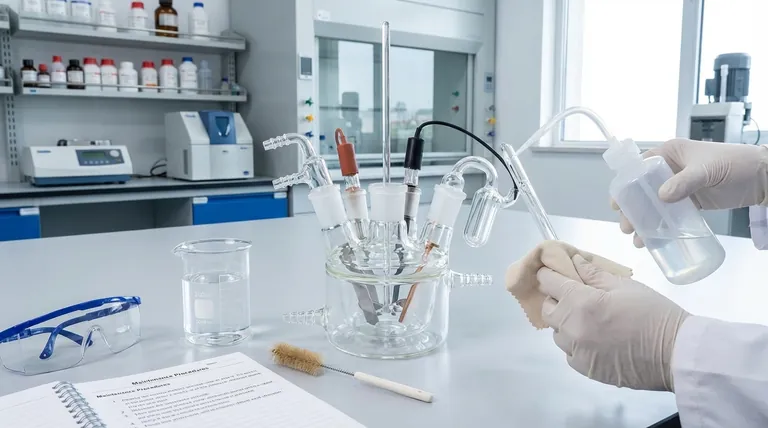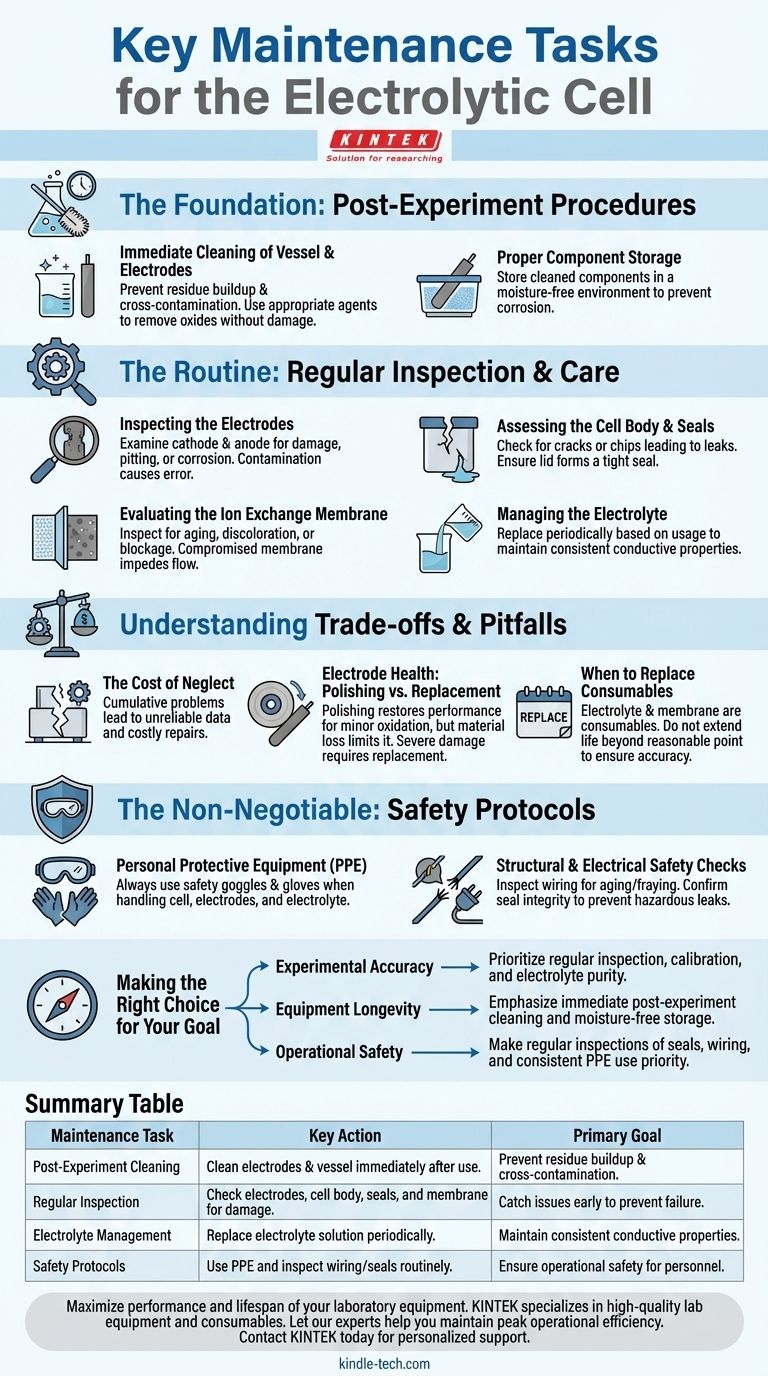Proper electrolytic cell maintenance is a disciplined routine revolving around four key activities. These include immediate cleaning of the electrodes and vessel after each use, regular inspection of all components for wear and damage, periodic replacement of the electrolyte, and adherence to strict safety protocols.
The goal of maintenance is not merely to keep the cell clean, but to guarantee its reliability, accuracy, and operational safety. Consistent care transforms the cell from a piece of equipment into a predictable and trustworthy instrument for your work.

The Foundation: Post-Experiment Procedures
The actions you take immediately following an experiment have the greatest impact on the cell's long-term performance and lifespan.
Immediate Cleaning of Vessel and Electrodes
Cleaning should be performed directly after each experiment. This prevents residue buildup and cross-contamination that can compromise future results.
Use appropriate cleaning agents to gently remove any oxides or deposits from the electrode surfaces without causing physical damage.
Proper Component Storage
Once cleaned and dried, all components should be stored in a moisture-free environment. This simple step is critical for preventing corrosion and degradation of sensitive parts, especially the electrodes.
The Routine: Regular Inspection and Care
A consistent inspection schedule is necessary to catch potential issues before they lead to equipment failure or inaccurate data.
Inspecting the Electrodes
Regularly examine the cathode and anode for signs of physical damage, pitting, or corrosion. Contaminated or damaged electrodes are a primary source of experimental error.
Assessing the Cell Body and Seals
Check the main cell body for any cracks or chips that could lead to leaks. Ensure the lid forms a tight, secure seal to maintain the integrity of the internal environment.
Evaluating the Ion Exchange Membrane
If your cell uses an ion exchange membrane, inspect it for signs of aging, discoloration, or blockage. A compromised membrane will impede ion flow and degrade cell efficiency.
Managing the Electrolyte
The electrolyte solution must be replaced periodically. The frequency depends on usage, as repeated experiments can deplete the ions or introduce contaminants, altering its conductive properties.
Understanding the Trade-offs and Pitfalls
Effective maintenance involves knowing when a simple cleaning is sufficient and when a component requires more significant intervention or replacement.
The Cost of Neglect
Skipping immediate cleaning or regular inspections leads to cumulative problems. Minor residue can harden, oxides can corrupt electrode surfaces, and small cracks can become major failures, all leading to unreliable data and costly repairs.
Electrode Health: Polishing vs. Replacement
For minor surface oxidation, polishing the electrodes can restore their performance. However, this removes material and cannot be done indefinitely. Severe pitting or physical damage means the electrode must be replaced.
When to Replace Consumables
The electrolyte and ion exchange membrane are consumables. Do not try to extend their life beyond a reasonable point. Attempting to do so is a false economy that directly jeopardizes the accuracy of your results.
The Non-Negotiable: Safety Protocols
Maintenance and safety are inextricably linked. A well-maintained cell is a safer cell.
Personal Protective Equipment (PPE)
Always use appropriate PPE, such as safety goggles and gloves, when handling the cell, its electrodes, and particularly the electrolyte solution.
Structural and Electrical Safety Checks
Incorporate safety checks into your maintenance routine. Inspect wiring for signs of aging or fraying and frequently confirm the integrity of all seals to prevent hazardous leaks.
Making the Right Choice for Your Goal
Your maintenance strategy should align with your primary objective.
- If your primary focus is experimental accuracy: Prioritize regular electrode inspection, periodic calibration, and ensuring the absolute purity of your electrolyte.
- If your primary focus is equipment longevity: Emphasize immediate post-experiment cleaning and proper moisture-free storage above all else.
- If your primary focus is operational safety: Make regular inspections of seals, wiring, and the consistent use of PPE your highest priority.
A disciplined maintenance routine ensures your electrolytic cell remains a reliable and accurate asset for your work.
Summary Table:
| Maintenance Task | Key Action | Primary Goal |
|---|---|---|
| Post-Experiment Cleaning | Clean electrodes & vessel immediately after use. | Prevent residue buildup & cross-contamination. |
| Regular Inspection | Check electrodes, cell body, seals, and membrane for damage. | Catch issues early to prevent failure. |
| Electrolyte Management | Replace electrolyte solution periodically. | Maintain consistent conductive properties. |
| Safety Protocols | Use PPE and inspect wiring/seals routinely. | Ensure operational safety for personnel. |
Maximize the performance and lifespan of your laboratory equipment. Proper maintenance is key to reliable results. KINTEK specializes in high-quality lab equipment and consumables, including electrolytic cells, to meet your precise research needs.
Let our experts help you maintain peak operational efficiency. Contact KINTEK today for personalized support and discover the right solutions for your laboratory.
Visual Guide

Related Products
- Double Layer Five-Port Water Bath Electrolytic Electrochemical Cell
- Electrolytic Electrochemical Cell with Five-Port
- Double-Layer Water Bath Electrolytic Electrochemical Cell
- Quartz Electrolytic Electrochemical Cell for Electrochemical Experiments
- Optical Water Bath Electrolytic Electrochemical Cell
People Also Ask
- What regular inspection and maintenance activities are required for the electrolytic cell? Ensure Reliable Results & Extend Equipment Life
- What safety precautions should be taken during an experiment with the electrolytic cell? A Guide to Preventing Shocks, Burns, and Fires
- What is the applicable temperature range for the electrolytic cell and how is the temperature controlled? Achieve Precise Electrochemical Results
- What precautions should be taken regarding temperature control for the electrolytic cell? Ensure Safe & Accurate Electrolysis
- How should a double-layer water-bath electrolytic cell be operated? A Step-by-Step Guide for Reliable Results



















